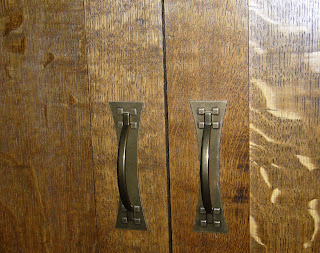So, if I was swatching in muted colours of J&S jumperweight, how is it possible that the finished hat looks like this?
On Saturday I went to the AGM of the Mid-Essex Spinners' and Weavers' Guild. Someone brought in two large crates of yarn which she wanted to clear out. I picked out a ball in this deep periwinkle blue, and another in cream, in roughly the same weight. Another ball, this time a laceweight, in the same periwinkle - 50p, said the person on the sales table, for the three. Working on the principle that it is better to use random harvests straight away, I made a swatch. It was odd yarn, varying in thickness, but looking mostly like a 4 ply. The cream was a little heavier, but that just seemed to add texture to the motifs.
Making up the pattern as I went along, I found it helpful to pull all the stitches off the needles a couple of times to try the piece around my head. Then I thought a touch of red would lift the design, and I found instructions for the little braid. It was new to me. The main motifs are from Sheila Mcgregor's "Traditional Fair Isle Knitting", which I come back to every time. I was pretty sure that it would be too tight after the main motif, but in fact it is an exact fit and the ribbing provides a snug covering for the ears.
So what did I need a new hat for? My husband and I are not overly keen on exercise, certainly not on sport, but we enjoy cycling and walking. We have taken to including a cycle round some of the network of lanes which can be found in this part of Essex - traffic free, through rolling countryside, and providing that glow of well-being and self-righteousness which calls for a hearty lunch.
My husband, on his bike outside Great Tey church., a curious structure in which the tower dates from the12th Century, one wing from the 13th and the other from the 14th. On our first ride this year we were astonished to see a herd of twenty wild deer standing right in the middle of an open field very near to this church. Essex is a very heavily populated county, its major roads often congested, yet the lanes are deeply rural still.
Arriving home from our rides, we have really enjoyed the home-made soup we had left on the hob, ready to reheat. I was shown how to make this by my younger sister five years ago, and since then we have eaten gallons of it. Using one onion, two carrots, a potato, plus whatever else you have - some stalks of celery, a slice of swede - and a vegetable stock cube, it is also very thifty. The secret is to sweat the diced vegetables in a tablespoonful of oil before adding the stock, then mash the soup with a potato masher after it has simmered for about thirty minutes. Recently I have added a small amount of mixed lentils with the stock, which seems to add body to the mix. It is always the same, but always different.
And this is a skein of laceweight cashmere, bought from Hip-knits on a sale day. It was an insipid pale blue, so I have over-dyed it with a cold water dye. Much improved, I feel.































.JPG)